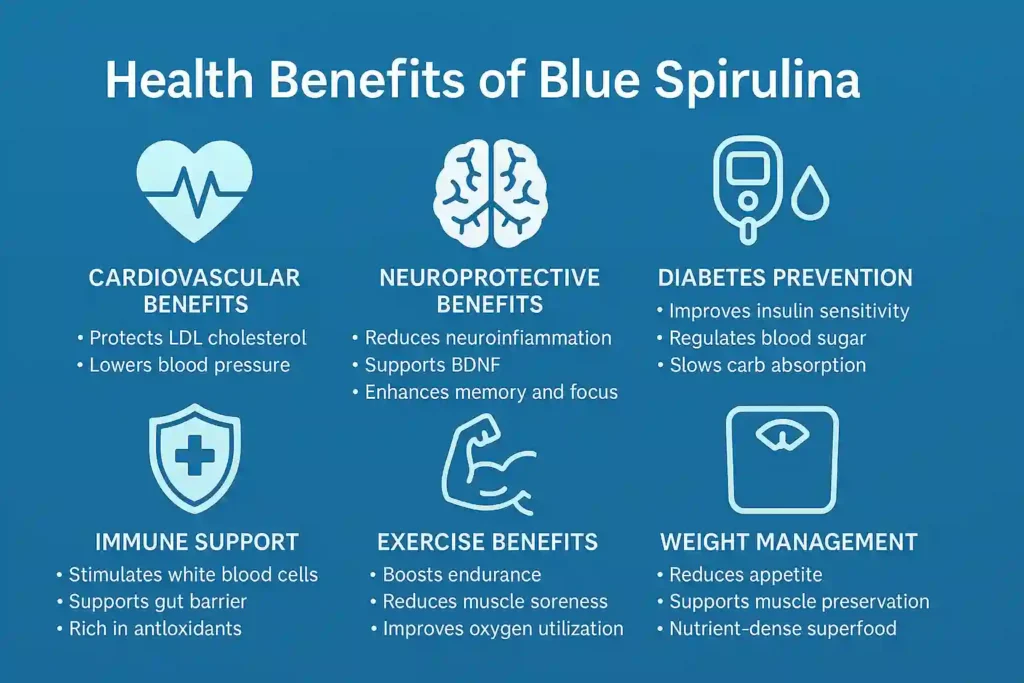Health benefits of blue spirulina go far beyond its striking color. Extracted from Arthrospira platensis, this pigment-rich form of spirulina is rich in phycocyanin, antioxidants, amino acids, vitamins, and minerals.
Table of Contents
ToggleWhile it often appears in smoothies and wellness bowls, its nutritional profile is gaining attention for serious health support, from heart health to brain protection.
What differentiates blue spirulina from its green counterpart is the extraction process that focuses on concentrating the phycocyanin pigment.
This makes it less earthy in flavor but still dense in nutrients. It’s a cleaner, more vibrant option for those seeking the benefits without the strong algae taste.
Cardiovascular Benefits of Blue Spirulina
Blue spirulina benefits for cardiovascular health come largely from its antioxidant and anti-inflammatory compounds. Phycocyanin in blue spirulina may help protect LDL cholesterol from oxidation, a process that contributes to artery damage and plaque buildup.
Studies show spirulina may also enhance nitric oxide production, which relaxes blood vessels and improves circulation. This supports lower blood pressure and improved oxygen delivery to tissues.
Its rich magnesium content helps regulate heart rhythm, while potassium supports balanced blood pressure. These nutrients, combined with its ability to reduce oxidative stress, make blue spirulina a natural ally for long-term heart health.
Neuroprotective Benefits of Blue Spirulina

Health benefits of blue spirulina for the brain are tied to its impact on oxidative stress, a major factor in age-related cognitive decline. Phycocyanin may help reduce neuroinflammation, which is linked to memory loss and degenerative brain conditions.
Animal models suggest spirulina supplementation can boost brain-derived neurotrophic factor (BDNF), a protein essential for the survival and growth of brain cells. This may translate into better learning capacity and improved mental sharpness over time.
The presence of amino acids, especially tryptophan, supports neurotransmitter production, influencing mood regulation and stress resilience. Its iron content also helps maintain optimal oxygen supply to brain tissues.
Blue Spirulina and Potential Benefits for Diabetes Prevention
Blue spirulina uses in blood sugar regulation are supported by early clinical evidence. Spirulina may improve fasting blood glucose levels and enhance insulin sensitivity, reducing the risk of type 2 diabetes progression.
Phycocyanin’s anti-inflammatory properties play a role here, as inflammation is closely tied to insulin resistance. Additionally, blue spirulina’s high protein and fiber content slow carbohydrate absorption, preventing rapid blood sugar spikes after meals.
Its chromium content may further support healthy glucose metabolism by assisting insulin’s function. For those at risk of metabolic syndrome, blue spirulina can be a low-calorie, nutrient-rich addition to a balanced diet.
Possible Immune System Benefits of Blue Spirulina
The immune system benefits of blue spirulina result from its unique combination of phycocyanin, antioxidants, and micronutrients. Phycocyanin stimulates bone marrow activity, potentially enhancing the production of infection-fighting white blood cells.
The beta-carotene in spirulina acts as a precursor to vitamin A, vital for maintaining healthy mucous membranes, the body’s first line of defense against pathogens.
Zinc, iron, and B vitamins in blue spirulina help keep immune cells functioning at their peak, while its antioxidants protect these cells from free radical damage. Consistent intake may shorten recovery times during illness.
Exercise Benefits of Blue Spirulina
Blue spirulina benefits extend to exercise performance and recovery. Its high antioxidant load helps neutralize free radicals generated during intense training, reducing muscle soreness and supporting faster tissue repair.
Phycocyanin may improve oxygen utilization, meaning muscles receive more fuel during exertion. This could enhance endurance and delay fatigue in athletes.
The plant-based protein source content supports muscle maintenance and growth, while minerals like magnesium aid in preventing cramps.
Athletes often add spirulina to pre- and post-workout nutrition for its combined anti-inflammatory and recovery-supporting properties.
Blue Spirulina and Weight Management
Blue spirulina is a low-calorie, protein-rich superfood that can help reduce appetite while supporting muscle preservation during calorie restriction.
Its protein stimulates the release of hormones like peptide YY and GLP-1, which signal fullness to the brain. This reduces snacking and helps maintain a calorie deficit without extreme hunger.
Because it’s nutrient-dense, blue spirulina allows for better nutrition even in reduced-calorie diets. This makes it a smart choice for long-term, sustainable weight loss strategies.
The Bottom Line
As a food product, blue spirulina is a rich source of phycocyanin, known for its antioxidant, anti-inflammatory, and immune-supportive properties. Whether for heart health, brain support, exercise recovery, or weight control, blue spirulina offers a well-rounded nutritional boost.
It’s best used alongside a varied diet rather than as a single “miracle” immune boosting supplement. Opt for reputable, tested products to avoid contamination, quality matters for both safety and results.
FAQs
What is the health benefit of blue spirulina?
It may support heart, brain, blood sugar, immune function, and exercise recovery, while helping with weight control through its protein, antioxidants, and anti-inflammatory compounds.
Which is better blue or green spirulina?
Blue spirulina is milder in taste and concentrated in phycocyanin. Green spirulina contains the whole algae with extra nutrients like chlorophyll, but a stronger, earthy flavor.
What is better, spirulina or moringa?
Spirulina offers more protein and certain antioxidants. Moringa provides higher vitamin C and calcium. Both are nutrient-rich; the choice depends on your health needs and taste preference.
Is spirulina safe for kidneys?
Generally safe for healthy kidneys. Those with kidney disease should avoid high-mineral supplements like spirulina unless approved by a doctor to prevent excess strain on the organs.
Can blue spirulina help with detoxification?
Yes. Its antioxidants and nutrient profile may support liver function and assist the body’s natural toxin elimination, though it should be part of an overall balanced, detox-friendly diet.
What nutrients are found in blue spirulina?
It contains protein, B vitamins, iron, magnesium, potassium, and the antioxidant pigment phycocyanin, all of which support multiple systems in the body for overall health.
Does blue spirulina contain protein?
Yes. It’s a high-quality plant-based protein source containing all essential amino acids, making it a complete protein suitable for vegan and vegetarian diets.

This article is medically reviewed by Dr. Nivedita Pandey, Senior Gastroenterologist and Hepatologist, ensuring accurate and reliable health information.
Dr. Nivedita Pandey is a U.S.-trained gastroenterologist specializing in pre and post-liver transplant care, as well as managing chronic gastrointestinal disorders. Known for her compassionate and patient-centered approach, Dr. Pandey is dedicated to delivering the highest quality of care to each patient.








